Factors Influencing ISO 9000 Implementation in Chinese Firms: A Study
VerifiedAdded on 2023/01/04
|31
|4309
|33
Report
AI Summary
This report presents a comprehensive analysis of the critical factors influencing the implementation of ISO 9000 standards within Chinese firms, based on a sample of 5717 SMEs. The study reveals that ISO-certified firms generally exhibit higher revenue and profit compared to non-ISO firms, although non-ISO firms surprisingly demonstrate higher ROS and ROA. The research identifies significant correlations between firm age and financial metrics, as well as a notable relationship between industry type and ISO adoption. Key findings highlight the dominance of Business and Specialized technology services within the sample. The report recommends that ISO-compliant firms optimize asset utilization to improve ROS and ROA. The government should promote ISO adoption, especially in the Business and Specialized technology services sectors. Furthermore, the study emphasizes the importance of revenue and profit growth through ISO 9000 adoption for Chinese SMEs, providing valuable insights for business development and strategic planning.
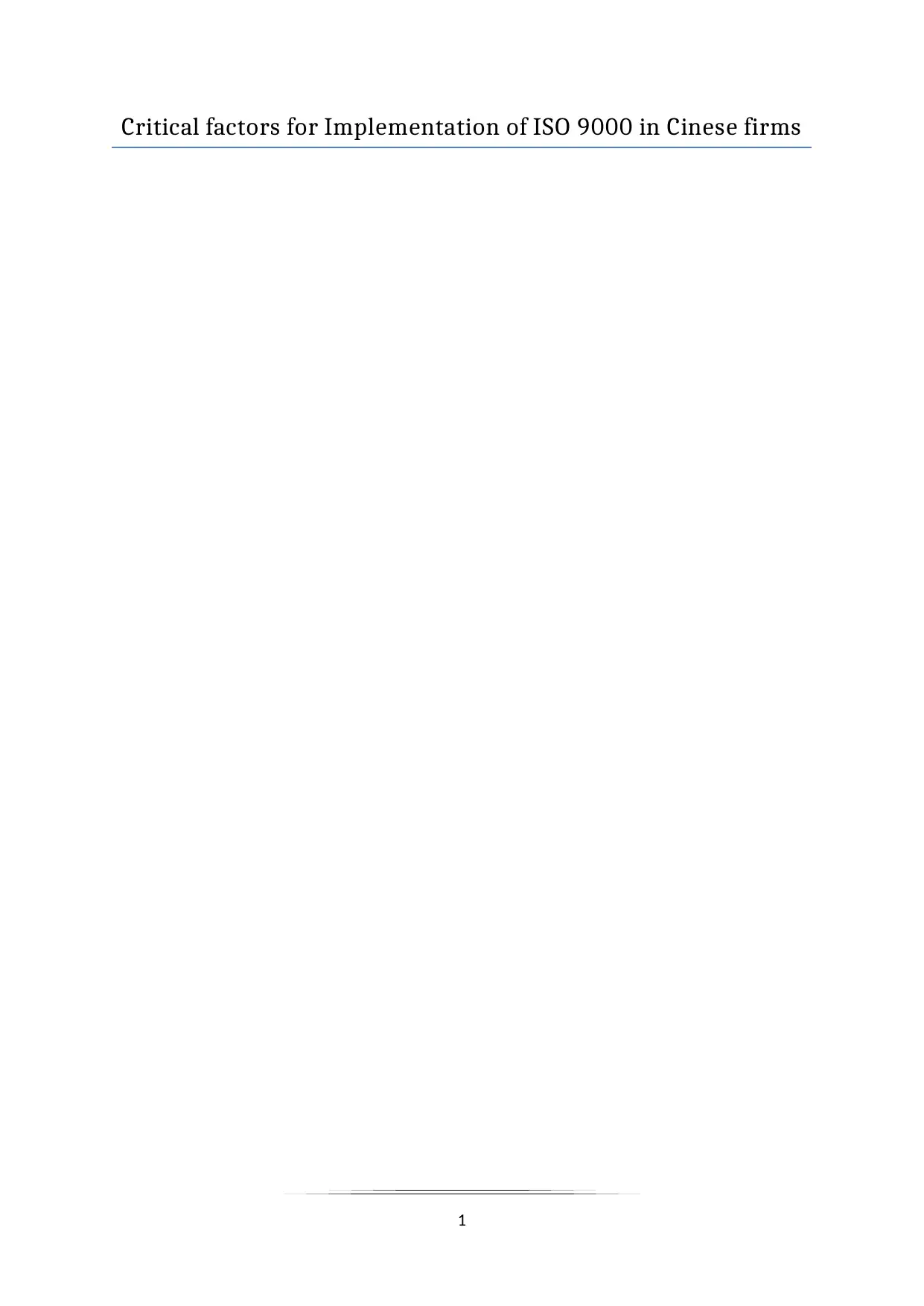
Critical factors for Implementation of ISO 9000 in Cinese firms
1
1
Paraphrase This Document
Need a fresh take? Get an instant paraphrase of this document with our AI Paraphraser
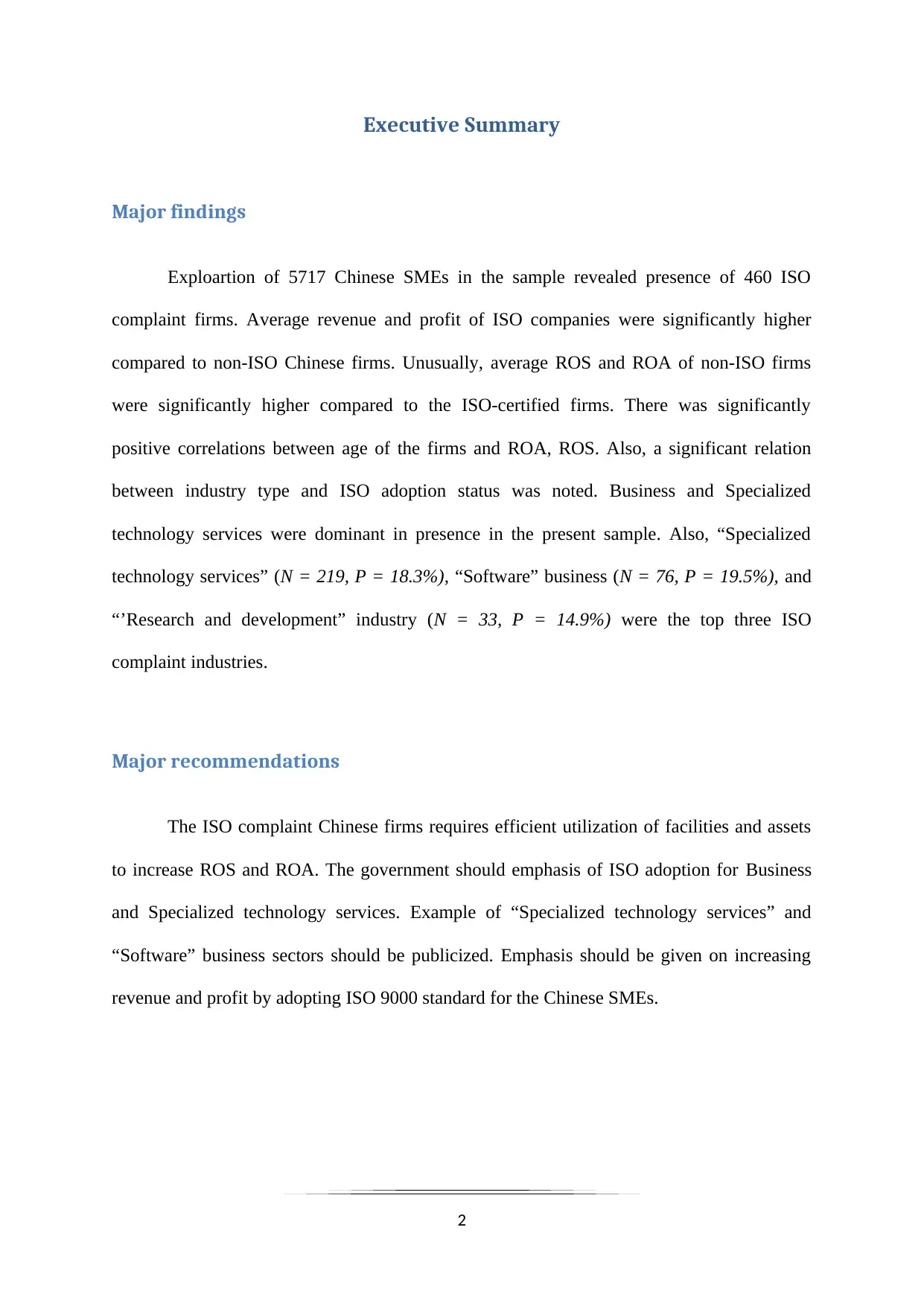
Executive Summary
Major findings
Exploartion of 5717 Chinese SMEs in the sample revealed presence of 460 ISO
complaint firms. Average revenue and profit of ISO companies were significantly higher
compared to non-ISO Chinese firms. Unusually, average ROS and ROA of non-ISO firms
were significantly higher compared to the ISO-certified firms. There was significantly
positive correlations between age of the firms and ROA, ROS. Also, a significant relation
between industry type and ISO adoption status was noted. Business and Specialized
technology services were dominant in presence in the present sample. Also, “Specialized
technology services” (N = 219, P = 18.3%), “Software” business (N = 76, P = 19.5%), and
“’Research and development” industry (N = 33, P = 14.9%) were the top three ISO
complaint industries.
Major recommendations
The ISO complaint Chinese firms requires efficient utilization of facilities and assets
to increase ROS and ROA. The government should emphasis of ISO adoption for Business
and Specialized technology services. Example of “Specialized technology services” and
“Software” business sectors should be publicized. Emphasis should be given on increasing
revenue and profit by adopting ISO 9000 standard for the Chinese SMEs.
2
Major findings
Exploartion of 5717 Chinese SMEs in the sample revealed presence of 460 ISO
complaint firms. Average revenue and profit of ISO companies were significantly higher
compared to non-ISO Chinese firms. Unusually, average ROS and ROA of non-ISO firms
were significantly higher compared to the ISO-certified firms. There was significantly
positive correlations between age of the firms and ROA, ROS. Also, a significant relation
between industry type and ISO adoption status was noted. Business and Specialized
technology services were dominant in presence in the present sample. Also, “Specialized
technology services” (N = 219, P = 18.3%), “Software” business (N = 76, P = 19.5%), and
“’Research and development” industry (N = 33, P = 14.9%) were the top three ISO
complaint industries.
Major recommendations
The ISO complaint Chinese firms requires efficient utilization of facilities and assets
to increase ROS and ROA. The government should emphasis of ISO adoption for Business
and Specialized technology services. Example of “Specialized technology services” and
“Software” business sectors should be publicized. Emphasis should be given on increasing
revenue and profit by adopting ISO 9000 standard for the Chinese SMEs.
2
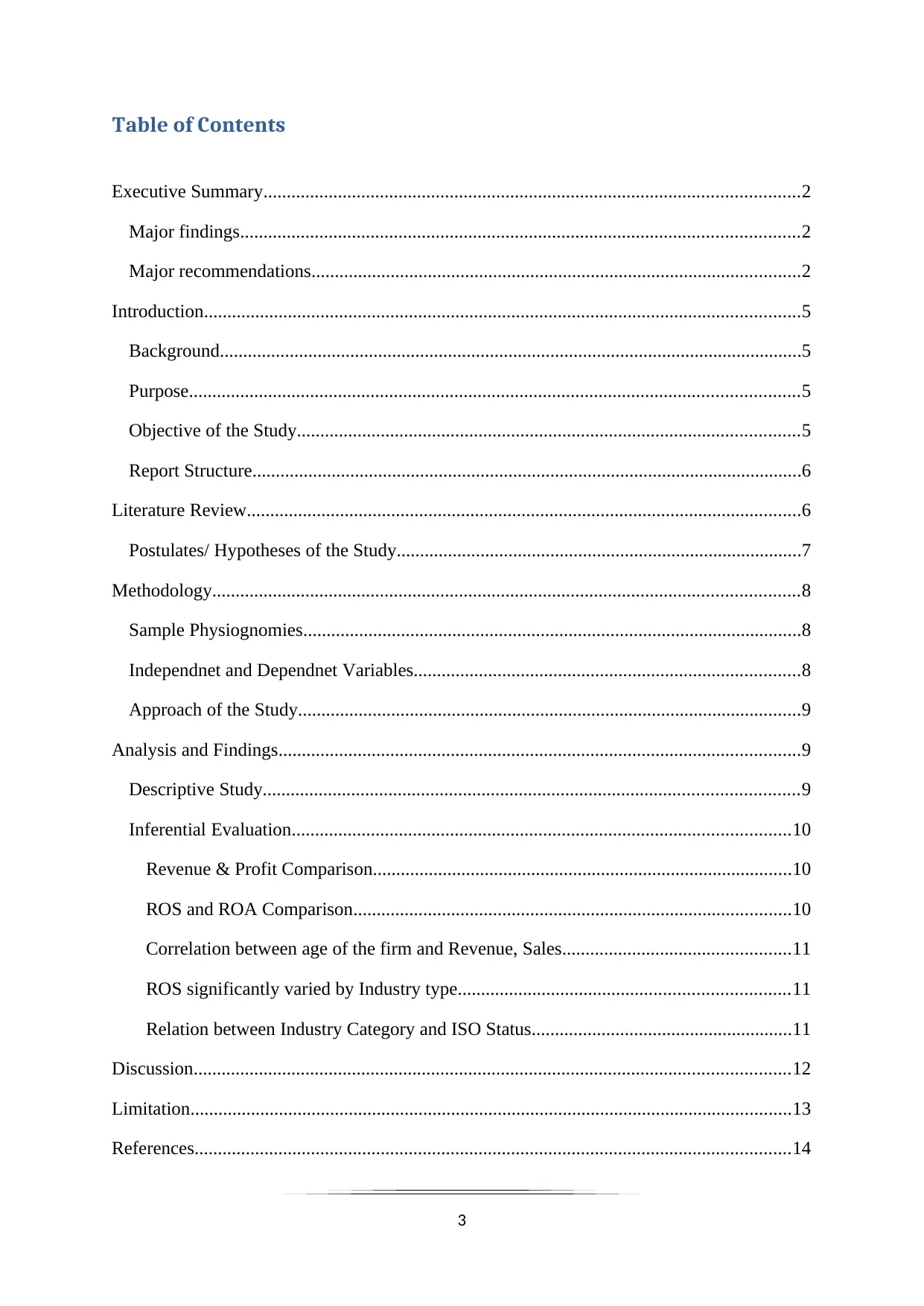
Table of Contents
Executive Summary...................................................................................................................2
Major findings........................................................................................................................2
Major recommendations.........................................................................................................2
Introduction................................................................................................................................5
Background.............................................................................................................................5
Purpose...................................................................................................................................5
Objective of the Study............................................................................................................5
Report Structure......................................................................................................................6
Literature Review.......................................................................................................................6
Postulates/ Hypotheses of the Study.......................................................................................7
Methodology..............................................................................................................................8
Sample Physiognomies...........................................................................................................8
Independnet and Dependnet Variables...................................................................................8
Approach of the Study............................................................................................................9
Analysis and Findings................................................................................................................9
Descriptive Study...................................................................................................................9
Inferential Evaluation...........................................................................................................10
Revenue & Profit Comparison..........................................................................................10
ROS and ROA Comparison..............................................................................................10
Correlation between age of the firm and Revenue, Sales.................................................11
ROS significantly varied by Industry type.......................................................................11
Relation between Industry Category and ISO Status........................................................11
Discussion................................................................................................................................12
Limitation.................................................................................................................................13
References................................................................................................................................14
3
Executive Summary...................................................................................................................2
Major findings........................................................................................................................2
Major recommendations.........................................................................................................2
Introduction................................................................................................................................5
Background.............................................................................................................................5
Purpose...................................................................................................................................5
Objective of the Study............................................................................................................5
Report Structure......................................................................................................................6
Literature Review.......................................................................................................................6
Postulates/ Hypotheses of the Study.......................................................................................7
Methodology..............................................................................................................................8
Sample Physiognomies...........................................................................................................8
Independnet and Dependnet Variables...................................................................................8
Approach of the Study............................................................................................................9
Analysis and Findings................................................................................................................9
Descriptive Study...................................................................................................................9
Inferential Evaluation...........................................................................................................10
Revenue & Profit Comparison..........................................................................................10
ROS and ROA Comparison..............................................................................................10
Correlation between age of the firm and Revenue, Sales.................................................11
ROS significantly varied by Industry type.......................................................................11
Relation between Industry Category and ISO Status........................................................11
Discussion................................................................................................................................12
Limitation.................................................................................................................................13
References................................................................................................................................14
3
⊘ This is a preview!⊘
Do you want full access?
Subscribe today to unlock all pages.

Trusted by 1+ million students worldwide
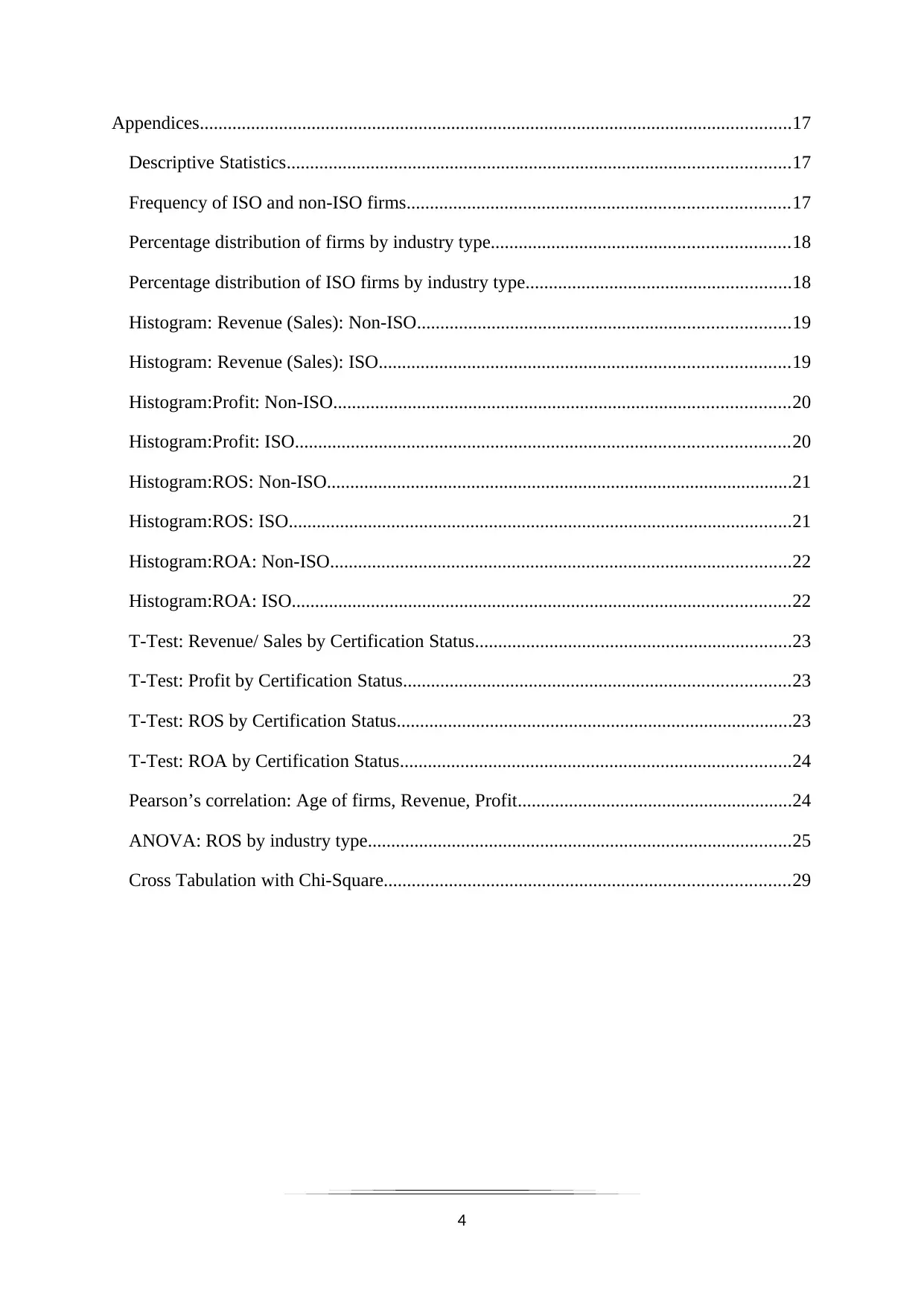
Appendices...............................................................................................................................17
Descriptive Statistics............................................................................................................17
Frequency of ISO and non-ISO firms..................................................................................17
Percentage distribution of firms by industry type................................................................18
Percentage distribution of ISO firms by industry type.........................................................18
Histogram: Revenue (Sales): Non-ISO................................................................................19
Histogram: Revenue (Sales): ISO........................................................................................19
Histogram:Profit: Non-ISO..................................................................................................20
Histogram:Profit: ISO..........................................................................................................20
Histogram:ROS: Non-ISO....................................................................................................21
Histogram:ROS: ISO............................................................................................................21
Histogram:ROA: Non-ISO...................................................................................................22
Histogram:ROA: ISO...........................................................................................................22
T-Test: Revenue/ Sales by Certification Status....................................................................23
T-Test: Profit by Certification Status...................................................................................23
T-Test: ROS by Certification Status.....................................................................................23
T-Test: ROA by Certification Status....................................................................................24
Pearson’s correlation: Age of firms, Revenue, Profit...........................................................24
ANOVA: ROS by industry type...........................................................................................25
Cross Tabulation with Chi-Square.......................................................................................29
4
Descriptive Statistics............................................................................................................17
Frequency of ISO and non-ISO firms..................................................................................17
Percentage distribution of firms by industry type................................................................18
Percentage distribution of ISO firms by industry type.........................................................18
Histogram: Revenue (Sales): Non-ISO................................................................................19
Histogram: Revenue (Sales): ISO........................................................................................19
Histogram:Profit: Non-ISO..................................................................................................20
Histogram:Profit: ISO..........................................................................................................20
Histogram:ROS: Non-ISO....................................................................................................21
Histogram:ROS: ISO............................................................................................................21
Histogram:ROA: Non-ISO...................................................................................................22
Histogram:ROA: ISO...........................................................................................................22
T-Test: Revenue/ Sales by Certification Status....................................................................23
T-Test: Profit by Certification Status...................................................................................23
T-Test: ROS by Certification Status.....................................................................................23
T-Test: ROA by Certification Status....................................................................................24
Pearson’s correlation: Age of firms, Revenue, Profit...........................................................24
ANOVA: ROS by industry type...........................................................................................25
Cross Tabulation with Chi-Square.......................................................................................29
4
Paraphrase This Document
Need a fresh take? Get an instant paraphrase of this document with our AI Paraphraser
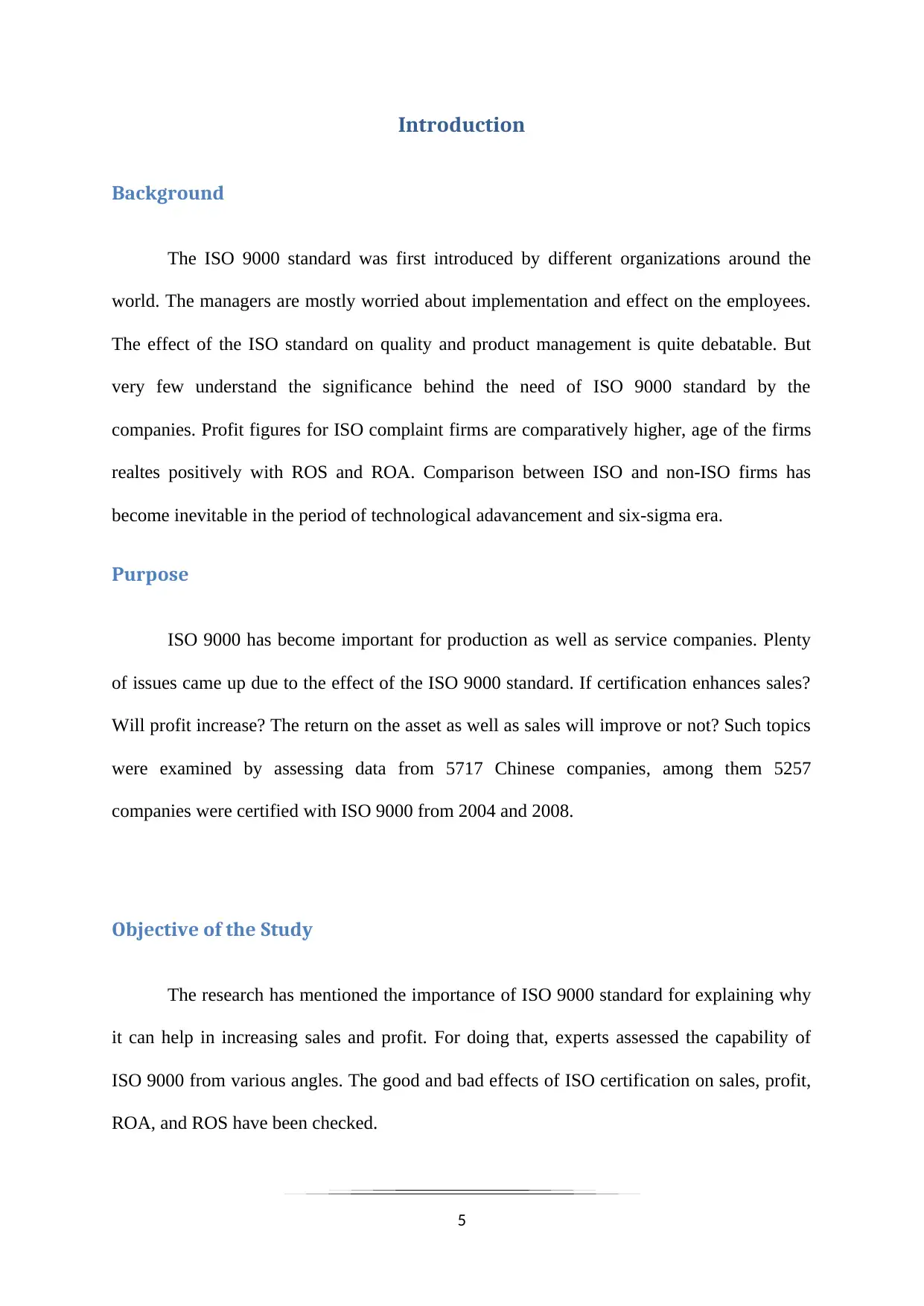
Introduction
Background
The ISO 9000 standard was first introduced by different organizations around the
world. The managers are mostly worried about implementation and effect on the employees.
The effect of the ISO standard on quality and product management is quite debatable. But
very few understand the significance behind the need of ISO 9000 standard by the
companies. Profit figures for ISO complaint firms are comparatively higher, age of the firms
realtes positively with ROS and ROA. Comparison between ISO and non-ISO firms has
become inevitable in the period of technological adavancement and six-sigma era.
Purpose
ISO 9000 has become important for production as well as service companies. Plenty
of issues came up due to the effect of the ISO 9000 standard. If certification enhances sales?
Will profit increase? The return on the asset as well as sales will improve or not? Such topics
were examined by assessing data from 5717 Chinese companies, among them 5257
companies were certified with ISO 9000 from 2004 and 2008.
Objective of the Study
The research has mentioned the importance of ISO 9000 standard for explaining why
it can help in increasing sales and profit. For doing that, experts assessed the capability of
ISO 9000 from various angles. The good and bad effects of ISO certification on sales, profit,
ROA, and ROS have been checked.
5
Background
The ISO 9000 standard was first introduced by different organizations around the
world. The managers are mostly worried about implementation and effect on the employees.
The effect of the ISO standard on quality and product management is quite debatable. But
very few understand the significance behind the need of ISO 9000 standard by the
companies. Profit figures for ISO complaint firms are comparatively higher, age of the firms
realtes positively with ROS and ROA. Comparison between ISO and non-ISO firms has
become inevitable in the period of technological adavancement and six-sigma era.
Purpose
ISO 9000 has become important for production as well as service companies. Plenty
of issues came up due to the effect of the ISO 9000 standard. If certification enhances sales?
Will profit increase? The return on the asset as well as sales will improve or not? Such topics
were examined by assessing data from 5717 Chinese companies, among them 5257
companies were certified with ISO 9000 from 2004 and 2008.
Objective of the Study
The research has mentioned the importance of ISO 9000 standard for explaining why
it can help in increasing sales and profit. For doing that, experts assessed the capability of
ISO 9000 from various angles. The good and bad effects of ISO certification on sales, profit,
ROA, and ROS have been checked.
5
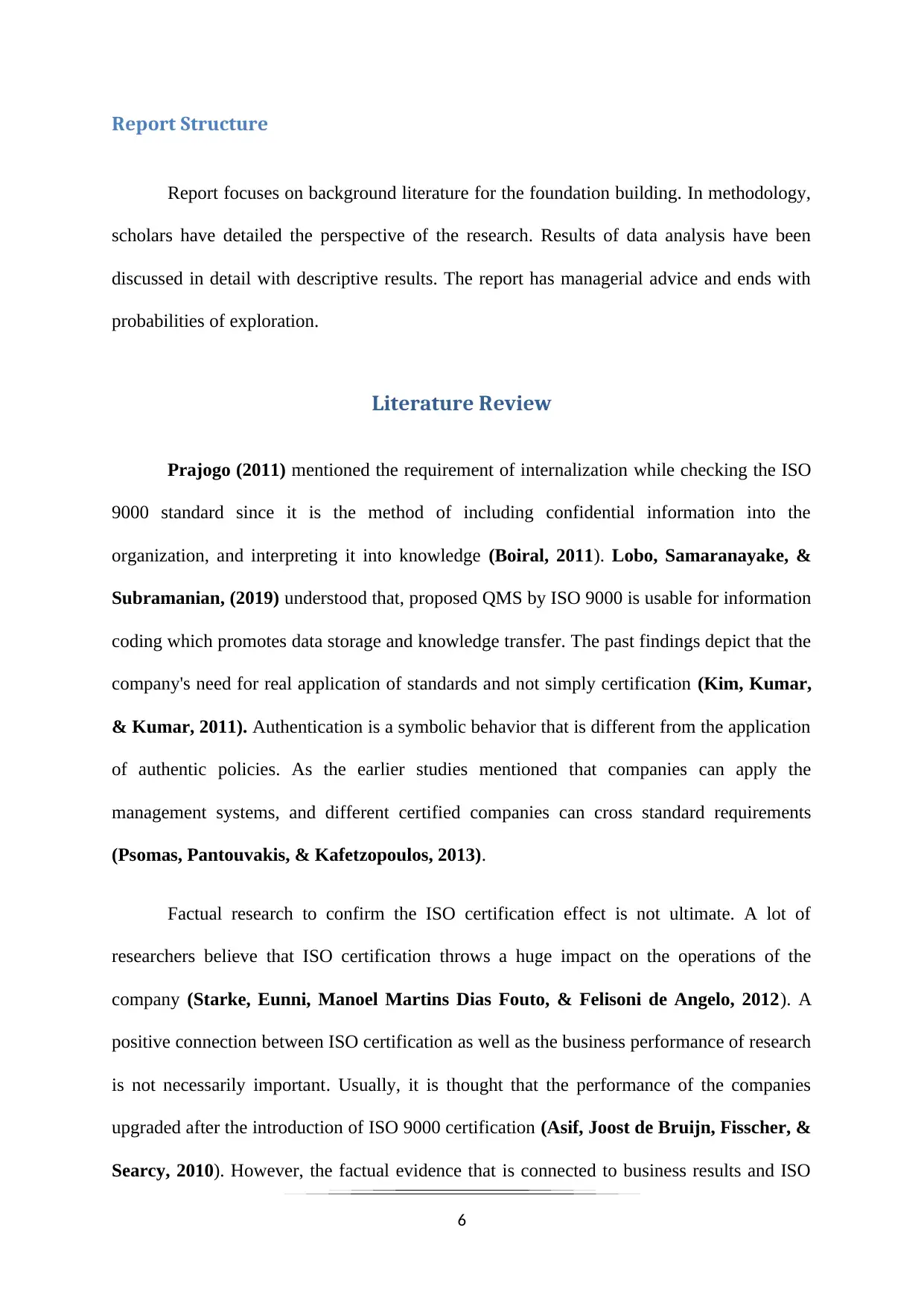
Report Structure
Report focuses on background literature for the foundation building. In methodology,
scholars have detailed the perspective of the research. Results of data analysis have been
discussed in detail with descriptive results. The report has managerial advice and ends with
probabilities of exploration.
Literature Review
Prajogo (2011) mentioned the requirement of internalization while checking the ISO
9000 standard since it is the method of including confidential information into the
organization, and interpreting it into knowledge (Boiral, 2011). Lobo, Samaranayake, &
Subramanian, (2019) understood that, proposed QMS by ISO 9000 is usable for information
coding which promotes data storage and knowledge transfer. The past findings depict that the
company's need for real application of standards and not simply certification (Kim, Kumar,
& Kumar, 2011). Authentication is a symbolic behavior that is different from the application
of authentic policies. As the earlier studies mentioned that companies can apply the
management systems, and different certified companies can cross standard requirements
(Psomas, Pantouvakis, & Kafetzopoulos, 2013).
Factual research to confirm the ISO certification effect is not ultimate. A lot of
researchers believe that ISO certification throws a huge impact on the operations of the
company (Starke, Eunni, Manoel Martins Dias Fouto, & Felisoni de Angelo, 2012). A
positive connection between ISO certification as well as the business performance of research
is not necessarily important. Usually, it is thought that the performance of the companies
upgraded after the introduction of ISO 9000 certification (Asif, Joost de Bruijn, Fisscher, &
Searcy, 2010). However, the factual evidence that is connected to business results and ISO
6
Report focuses on background literature for the foundation building. In methodology,
scholars have detailed the perspective of the research. Results of data analysis have been
discussed in detail with descriptive results. The report has managerial advice and ends with
probabilities of exploration.
Literature Review
Prajogo (2011) mentioned the requirement of internalization while checking the ISO
9000 standard since it is the method of including confidential information into the
organization, and interpreting it into knowledge (Boiral, 2011). Lobo, Samaranayake, &
Subramanian, (2019) understood that, proposed QMS by ISO 9000 is usable for information
coding which promotes data storage and knowledge transfer. The past findings depict that the
company's need for real application of standards and not simply certification (Kim, Kumar,
& Kumar, 2011). Authentication is a symbolic behavior that is different from the application
of authentic policies. As the earlier studies mentioned that companies can apply the
management systems, and different certified companies can cross standard requirements
(Psomas, Pantouvakis, & Kafetzopoulos, 2013).
Factual research to confirm the ISO certification effect is not ultimate. A lot of
researchers believe that ISO certification throws a huge impact on the operations of the
company (Starke, Eunni, Manoel Martins Dias Fouto, & Felisoni de Angelo, 2012). A
positive connection between ISO certification as well as the business performance of research
is not necessarily important. Usually, it is thought that the performance of the companies
upgraded after the introduction of ISO 9000 certification (Asif, Joost de Bruijn, Fisscher, &
Searcy, 2010). However, the factual evidence that is connected to business results and ISO
6
⊘ This is a preview!⊘
Do you want full access?
Subscribe today to unlock all pages.

Trusted by 1+ million students worldwide
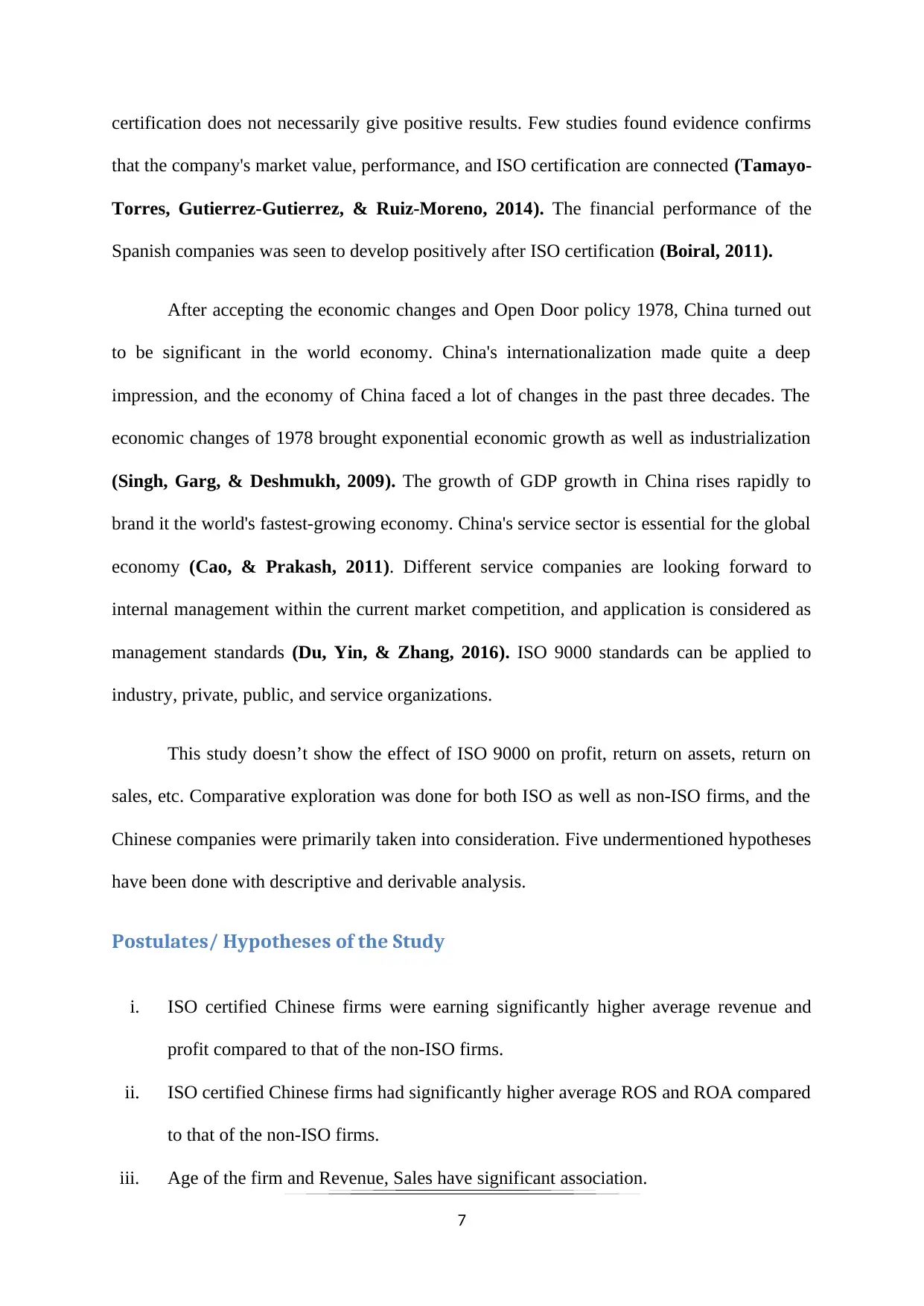
certification does not necessarily give positive results. Few studies found evidence confirms
that the company's market value, performance, and ISO certification are connected (Tamayo-
Torres, Gutierrez-Gutierrez, & Ruiz-Moreno, 2014). The financial performance of the
Spanish companies was seen to develop positively after ISO certification (Boiral, 2011).
After accepting the economic changes and Open Door policy 1978, China turned out
to be significant in the world economy. China's internationalization made quite a deep
impression, and the economy of China faced a lot of changes in the past three decades. The
economic changes of 1978 brought exponential economic growth as well as industrialization
(Singh, Garg, & Deshmukh, 2009). The growth of GDP growth in China rises rapidly to
brand it the world's fastest-growing economy. China's service sector is essential for the global
economy (Cao, & Prakash, 2011). Different service companies are looking forward to
internal management within the current market competition, and application is considered as
management standards (Du, Yin, & Zhang, 2016). ISO 9000 standards can be applied to
industry, private, public, and service organizations.
This study doesn’t show the effect of ISO 9000 on profit, return on assets, return on
sales, etc. Comparative exploration was done for both ISO as well as non-ISO firms, and the
Chinese companies were primarily taken into consideration. Five undermentioned hypotheses
have been done with descriptive and derivable analysis.
Postulates/ Hypotheses of the Study
i. ISO certified Chinese firms were earning significantly higher average revenue and
profit compared to that of the non-ISO firms.
ii. ISO certified Chinese firms had significantly higher average ROS and ROA compared
to that of the non-ISO firms.
iii. Age of the firm and Revenue, Sales have significant association.
7
that the company's market value, performance, and ISO certification are connected (Tamayo-
Torres, Gutierrez-Gutierrez, & Ruiz-Moreno, 2014). The financial performance of the
Spanish companies was seen to develop positively after ISO certification (Boiral, 2011).
After accepting the economic changes and Open Door policy 1978, China turned out
to be significant in the world economy. China's internationalization made quite a deep
impression, and the economy of China faced a lot of changes in the past three decades. The
economic changes of 1978 brought exponential economic growth as well as industrialization
(Singh, Garg, & Deshmukh, 2009). The growth of GDP growth in China rises rapidly to
brand it the world's fastest-growing economy. China's service sector is essential for the global
economy (Cao, & Prakash, 2011). Different service companies are looking forward to
internal management within the current market competition, and application is considered as
management standards (Du, Yin, & Zhang, 2016). ISO 9000 standards can be applied to
industry, private, public, and service organizations.
This study doesn’t show the effect of ISO 9000 on profit, return on assets, return on
sales, etc. Comparative exploration was done for both ISO as well as non-ISO firms, and the
Chinese companies were primarily taken into consideration. Five undermentioned hypotheses
have been done with descriptive and derivable analysis.
Postulates/ Hypotheses of the Study
i. ISO certified Chinese firms were earning significantly higher average revenue and
profit compared to that of the non-ISO firms.
ii. ISO certified Chinese firms had significantly higher average ROS and ROA compared
to that of the non-ISO firms.
iii. Age of the firm and Revenue, Sales have significant association.
7
Paraphrase This Document
Need a fresh take? Get an instant paraphrase of this document with our AI Paraphraser
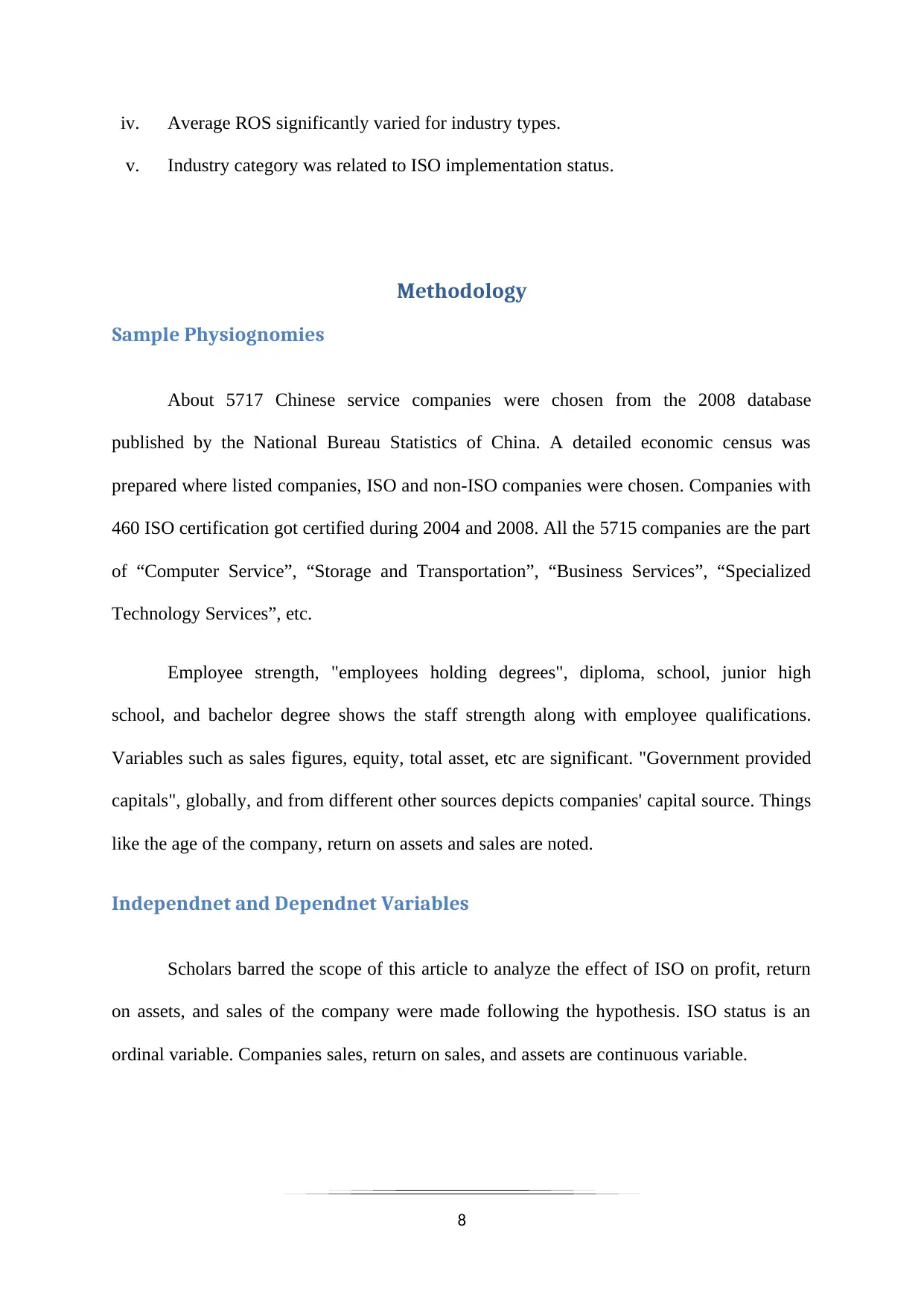
iv. Average ROS significantly varied for industry types.
v. Industry category was related to ISO implementation status.
Methodology
Sample Physiognomies
About 5717 Chinese service companies were chosen from the 2008 database
published by the National Bureau Statistics of China. A detailed economic census was
prepared where listed companies, ISO and non-ISO companies were chosen. Companies with
460 ISO certification got certified during 2004 and 2008. All the 5715 companies are the part
of “Computer Service”, “Storage and Transportation”, “Business Services”, “Specialized
Technology Services”, etc.
Employee strength, "employees holding degrees", diploma, school, junior high
school, and bachelor degree shows the staff strength along with employee qualifications.
Variables such as sales figures, equity, total asset, etc are significant. "Government provided
capitals", globally, and from different other sources depicts companies' capital source. Things
like the age of the company, return on assets and sales are noted.
Independnet and Dependnet Variables
Scholars barred the scope of this article to analyze the effect of ISO on profit, return
on assets, and sales of the company were made following the hypothesis. ISO status is an
ordinal variable. Companies sales, return on sales, and assets are continuous variable.
8
v. Industry category was related to ISO implementation status.
Methodology
Sample Physiognomies
About 5717 Chinese service companies were chosen from the 2008 database
published by the National Bureau Statistics of China. A detailed economic census was
prepared where listed companies, ISO and non-ISO companies were chosen. Companies with
460 ISO certification got certified during 2004 and 2008. All the 5715 companies are the part
of “Computer Service”, “Storage and Transportation”, “Business Services”, “Specialized
Technology Services”, etc.
Employee strength, "employees holding degrees", diploma, school, junior high
school, and bachelor degree shows the staff strength along with employee qualifications.
Variables such as sales figures, equity, total asset, etc are significant. "Government provided
capitals", globally, and from different other sources depicts companies' capital source. Things
like the age of the company, return on assets and sales are noted.
Independnet and Dependnet Variables
Scholars barred the scope of this article to analyze the effect of ISO on profit, return
on assets, and sales of the company were made following the hypothesis. ISO status is an
ordinal variable. Companies sales, return on sales, and assets are continuous variable.
8
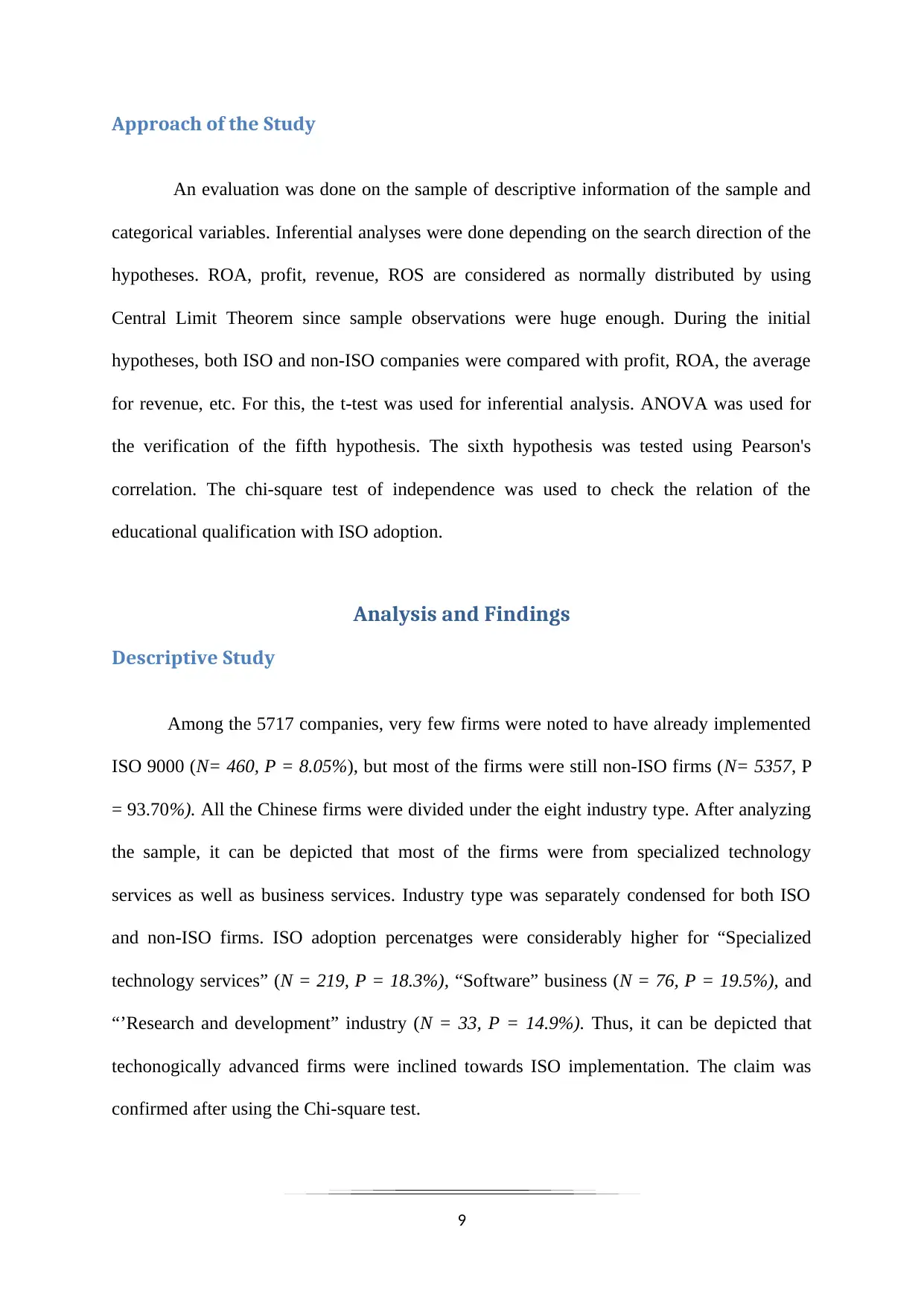
Approach of the Study
An evaluation was done on the sample of descriptive information of the sample and
categorical variables. Inferential analyses were done depending on the search direction of the
hypotheses. ROA, profit, revenue, ROS are considered as normally distributed by using
Central Limit Theorem since sample observations were huge enough. During the initial
hypotheses, both ISO and non-ISO companies were compared with profit, ROA, the average
for revenue, etc. For this, the t-test was used for inferential analysis. ANOVA was used for
the verification of the fifth hypothesis. The sixth hypothesis was tested using Pearson's
correlation. The chi-square test of independence was used to check the relation of the
educational qualification with ISO adoption.
Analysis and Findings
Descriptive Study
Among the 5717 companies, very few firms were noted to have already implemented
ISO 9000 (N= 460, P = 8.05%), but most of the firms were still non-ISO firms (N= 5357, P
= 93.70%). All the Chinese firms were divided under the eight industry type. After analyzing
the sample, it can be depicted that most of the firms were from specialized technology
services as well as business services. Industry type was separately condensed for both ISO
and non-ISO firms. ISO adoption percenatges were considerably higher for “Specialized
technology services” (N = 219, P = 18.3%), “Software” business (N = 76, P = 19.5%), and
“’Research and development” industry (N = 33, P = 14.9%). Thus, it can be depicted that
techonogically advanced firms were inclined towards ISO implementation. The claim was
confirmed after using the Chi-square test.
9
An evaluation was done on the sample of descriptive information of the sample and
categorical variables. Inferential analyses were done depending on the search direction of the
hypotheses. ROA, profit, revenue, ROS are considered as normally distributed by using
Central Limit Theorem since sample observations were huge enough. During the initial
hypotheses, both ISO and non-ISO companies were compared with profit, ROA, the average
for revenue, etc. For this, the t-test was used for inferential analysis. ANOVA was used for
the verification of the fifth hypothesis. The sixth hypothesis was tested using Pearson's
correlation. The chi-square test of independence was used to check the relation of the
educational qualification with ISO adoption.
Analysis and Findings
Descriptive Study
Among the 5717 companies, very few firms were noted to have already implemented
ISO 9000 (N= 460, P = 8.05%), but most of the firms were still non-ISO firms (N= 5357, P
= 93.70%). All the Chinese firms were divided under the eight industry type. After analyzing
the sample, it can be depicted that most of the firms were from specialized technology
services as well as business services. Industry type was separately condensed for both ISO
and non-ISO firms. ISO adoption percenatges were considerably higher for “Specialized
technology services” (N = 219, P = 18.3%), “Software” business (N = 76, P = 19.5%), and
“’Research and development” industry (N = 33, P = 14.9%). Thus, it can be depicted that
techonogically advanced firms were inclined towards ISO implementation. The claim was
confirmed after using the Chi-square test.
9
⊘ This is a preview!⊘
Do you want full access?
Subscribe today to unlock all pages.

Trusted by 1+ million students worldwide
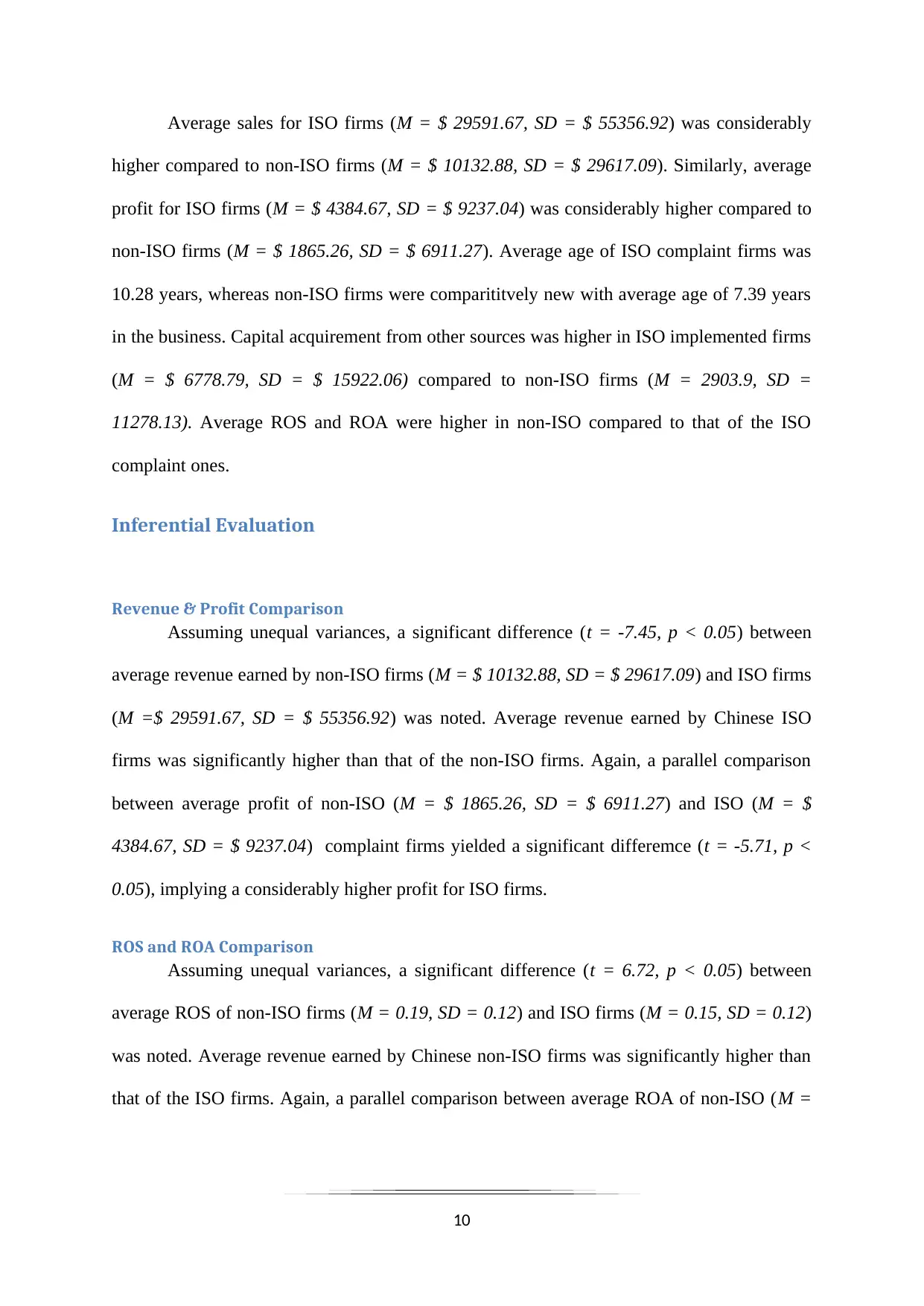
Average sales for ISO firms (M = $ 29591.67, SD = $ 55356.92) was considerably
higher compared to non-ISO firms (M = $ 10132.88, SD = $ 29617.09). Similarly, average
profit for ISO firms (M = $ 4384.67, SD = $ 9237.04) was considerably higher compared to
non-ISO firms (M = $ 1865.26, SD = $ 6911.27). Average age of ISO complaint firms was
10.28 years, whereas non-ISO firms were comparititvely new with average age of 7.39 years
in the business. Capital acquirement from other sources was higher in ISO implemented firms
(M = $ 6778.79, SD = $ 15922.06) compared to non-ISO firms (M = 2903.9, SD =
11278.13). Average ROS and ROA were higher in non-ISO compared to that of the ISO
complaint ones.
Inferential Evaluation
Revenue & Profit Comparison
Assuming unequal variances, a significant difference (t = -7.45, p < 0.05) between
average revenue earned by non-ISO firms (M = $ 10132.88, SD = $ 29617.09) and ISO firms
(M =$ 29591.67, SD = $ 55356.92) was noted. Average revenue earned by Chinese ISO
firms was significantly higher than that of the non-ISO firms. Again, a parallel comparison
between average profit of non-ISO (M = $ 1865.26, SD = $ 6911.27) and ISO (M = $
4384.67, SD = $ 9237.04) complaint firms yielded a significant differemce (t = -5.71, p <
0.05), implying a considerably higher profit for ISO firms.
ROS and ROA Comparison
Assuming unequal variances, a significant difference (t = 6.72, p < 0.05) between
average ROS of non-ISO firms (M = 0.19, SD = 0.12) and ISO firms (M = 0.15, SD = 0.12)
was noted. Average revenue earned by Chinese non-ISO firms was significantly higher than
that of the ISO firms. Again, a parallel comparison between average ROA of non-ISO (M =
10
higher compared to non-ISO firms (M = $ 10132.88, SD = $ 29617.09). Similarly, average
profit for ISO firms (M = $ 4384.67, SD = $ 9237.04) was considerably higher compared to
non-ISO firms (M = $ 1865.26, SD = $ 6911.27). Average age of ISO complaint firms was
10.28 years, whereas non-ISO firms were comparititvely new with average age of 7.39 years
in the business. Capital acquirement from other sources was higher in ISO implemented firms
(M = $ 6778.79, SD = $ 15922.06) compared to non-ISO firms (M = 2903.9, SD =
11278.13). Average ROS and ROA were higher in non-ISO compared to that of the ISO
complaint ones.
Inferential Evaluation
Revenue & Profit Comparison
Assuming unequal variances, a significant difference (t = -7.45, p < 0.05) between
average revenue earned by non-ISO firms (M = $ 10132.88, SD = $ 29617.09) and ISO firms
(M =$ 29591.67, SD = $ 55356.92) was noted. Average revenue earned by Chinese ISO
firms was significantly higher than that of the non-ISO firms. Again, a parallel comparison
between average profit of non-ISO (M = $ 1865.26, SD = $ 6911.27) and ISO (M = $
4384.67, SD = $ 9237.04) complaint firms yielded a significant differemce (t = -5.71, p <
0.05), implying a considerably higher profit for ISO firms.
ROS and ROA Comparison
Assuming unequal variances, a significant difference (t = 6.72, p < 0.05) between
average ROS of non-ISO firms (M = 0.19, SD = 0.12) and ISO firms (M = 0.15, SD = 0.12)
was noted. Average revenue earned by Chinese non-ISO firms was significantly higher than
that of the ISO firms. Again, a parallel comparison between average ROA of non-ISO (M =
10
Paraphrase This Document
Need a fresh take? Get an instant paraphrase of this document with our AI Paraphraser
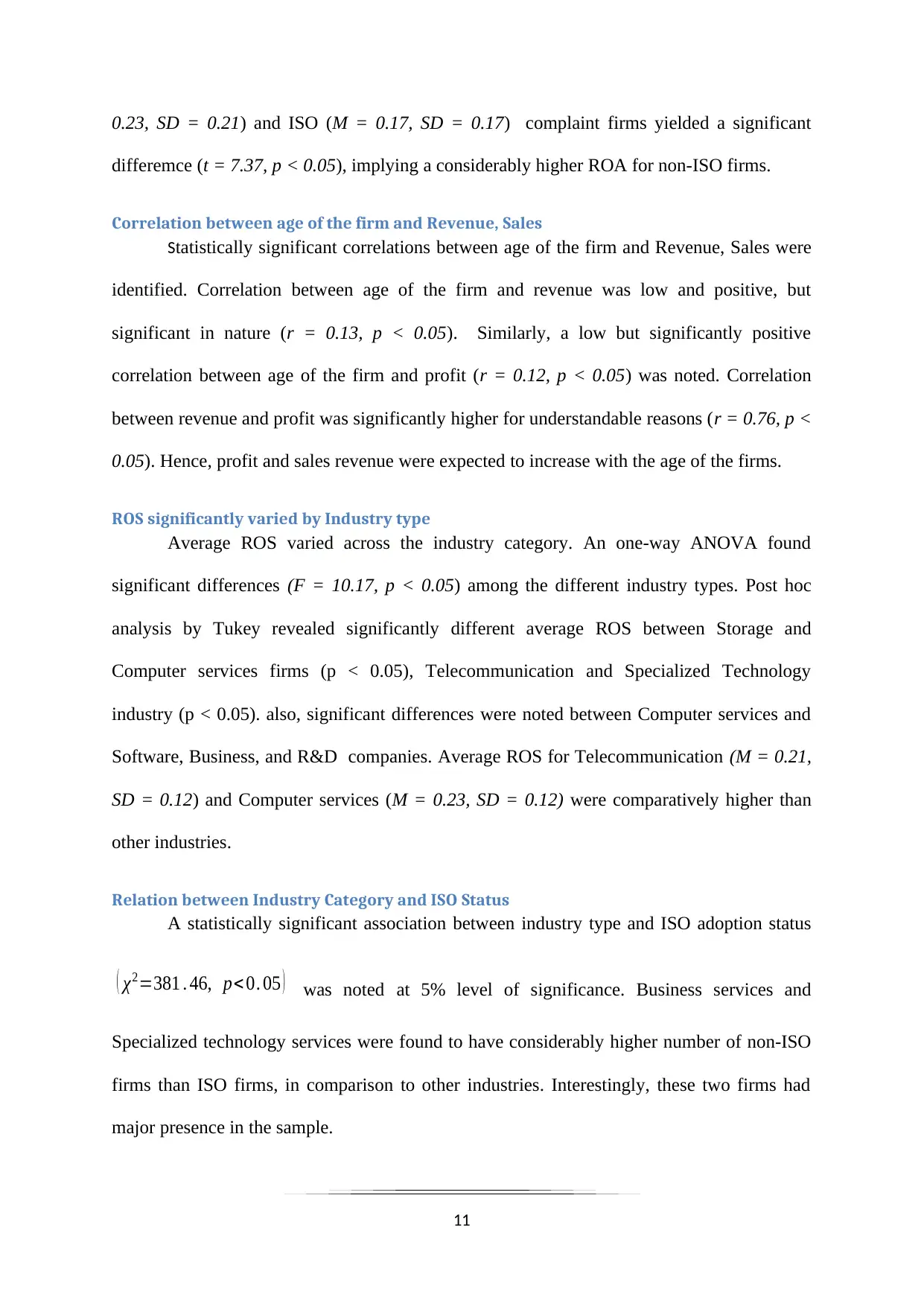
0.23, SD = 0.21) and ISO (M = 0.17, SD = 0.17) complaint firms yielded a significant
differemce (t = 7.37, p < 0.05), implying a considerably higher ROA for non-ISO firms.
Correlation between age of the firm and Revenue, Sales
Statistically significant correlations between age of the firm and Revenue, Sales were
identified. Correlation between age of the firm and revenue was low and positive, but
significant in nature (r = 0.13, p < 0.05). Similarly, a low but significantly positive
correlation between age of the firm and profit (r = 0.12, p < 0.05) was noted. Correlation
between revenue and profit was significantly higher for understandable reasons (r = 0.76, p <
0.05). Hence, profit and sales revenue were expected to increase with the age of the firms.
ROS significantly varied by Industry type
Average ROS varied across the industry category. An one-way ANOVA found
significant differences (F = 10.17, p < 0.05) among the different industry types. Post hoc
analysis by Tukey revealed significantly different average ROS between Storage and
Computer services firms (p < 0.05), Telecommunication and Specialized Technology
industry (p < 0.05). also, significant differences were noted between Computer services and
Software, Business, and R&D companies. Average ROS for Telecommunication (M = 0.21,
SD = 0.12) and Computer services (M = 0.23, SD = 0.12) were comparatively higher than
other industries.
Relation between Industry Category and ISO Status
A statistically significant association between industry type and ISO adoption status
( χ2=381 . 46, p< 0. 05 ) was noted at 5% level of significance. Business services and
Specialized technology services were found to have considerably higher number of non-ISO
firms than ISO firms, in comparison to other industries. Interestingly, these two firms had
major presence in the sample.
11
differemce (t = 7.37, p < 0.05), implying a considerably higher ROA for non-ISO firms.
Correlation between age of the firm and Revenue, Sales
Statistically significant correlations between age of the firm and Revenue, Sales were
identified. Correlation between age of the firm and revenue was low and positive, but
significant in nature (r = 0.13, p < 0.05). Similarly, a low but significantly positive
correlation between age of the firm and profit (r = 0.12, p < 0.05) was noted. Correlation
between revenue and profit was significantly higher for understandable reasons (r = 0.76, p <
0.05). Hence, profit and sales revenue were expected to increase with the age of the firms.
ROS significantly varied by Industry type
Average ROS varied across the industry category. An one-way ANOVA found
significant differences (F = 10.17, p < 0.05) among the different industry types. Post hoc
analysis by Tukey revealed significantly different average ROS between Storage and
Computer services firms (p < 0.05), Telecommunication and Specialized Technology
industry (p < 0.05). also, significant differences were noted between Computer services and
Software, Business, and R&D companies. Average ROS for Telecommunication (M = 0.21,
SD = 0.12) and Computer services (M = 0.23, SD = 0.12) were comparatively higher than
other industries.
Relation between Industry Category and ISO Status
A statistically significant association between industry type and ISO adoption status
( χ2=381 . 46, p< 0. 05 ) was noted at 5% level of significance. Business services and
Specialized technology services were found to have considerably higher number of non-ISO
firms than ISO firms, in comparison to other industries. Interestingly, these two firms had
major presence in the sample.
11
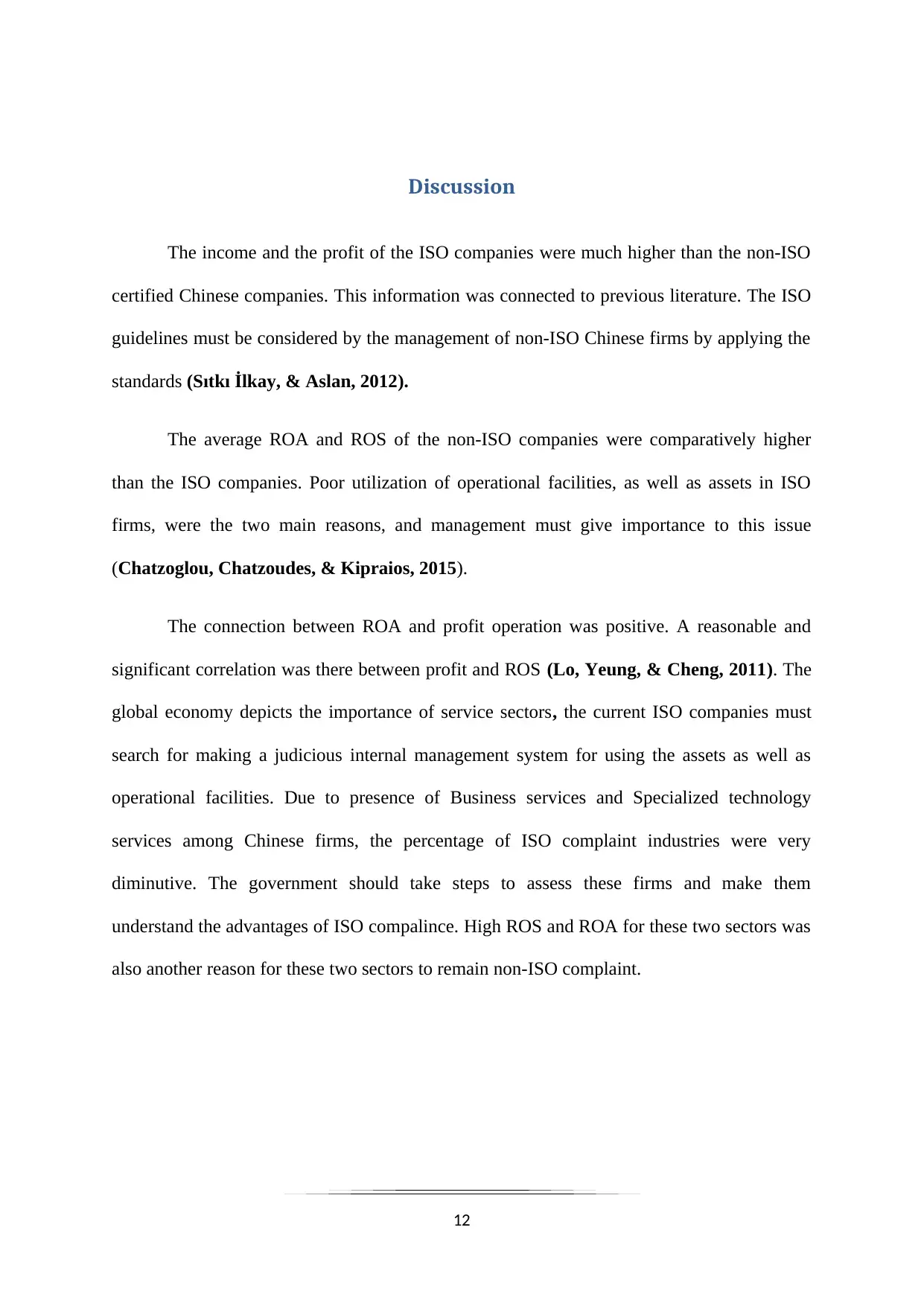
Discussion
The income and the profit of the ISO companies were much higher than the non-ISO
certified Chinese companies. This information was connected to previous literature. The ISO
guidelines must be considered by the management of non-ISO Chinese firms by applying the
standards (Sıtkı İlkay, & Aslan, 2012).
The average ROA and ROS of the non-ISO companies were comparatively higher
than the ISO companies. Poor utilization of operational facilities, as well as assets in ISO
firms, were the two main reasons, and management must give importance to this issue
(Chatzoglou, Chatzoudes, & Kipraios, 2015).
The connection between ROA and profit operation was positive. A reasonable and
significant correlation was there between profit and ROS (Lo, Yeung, & Cheng, 2011). The
global economy depicts the importance of service sectors, the current ISO companies must
search for making a judicious internal management system for using the assets as well as
operational facilities. Due to presence of Business services and Specialized technology
services among Chinese firms, the percentage of ISO complaint industries were very
diminutive. The government should take steps to assess these firms and make them
understand the advantages of ISO compalince. High ROS and ROA for these two sectors was
also another reason for these two sectors to remain non-ISO complaint.
12
The income and the profit of the ISO companies were much higher than the non-ISO
certified Chinese companies. This information was connected to previous literature. The ISO
guidelines must be considered by the management of non-ISO Chinese firms by applying the
standards (Sıtkı İlkay, & Aslan, 2012).
The average ROA and ROS of the non-ISO companies were comparatively higher
than the ISO companies. Poor utilization of operational facilities, as well as assets in ISO
firms, were the two main reasons, and management must give importance to this issue
(Chatzoglou, Chatzoudes, & Kipraios, 2015).
The connection between ROA and profit operation was positive. A reasonable and
significant correlation was there between profit and ROS (Lo, Yeung, & Cheng, 2011). The
global economy depicts the importance of service sectors, the current ISO companies must
search for making a judicious internal management system for using the assets as well as
operational facilities. Due to presence of Business services and Specialized technology
services among Chinese firms, the percentage of ISO complaint industries were very
diminutive. The government should take steps to assess these firms and make them
understand the advantages of ISO compalince. High ROS and ROA for these two sectors was
also another reason for these two sectors to remain non-ISO complaint.
12
⊘ This is a preview!⊘
Do you want full access?
Subscribe today to unlock all pages.

Trusted by 1+ million students worldwide
1 out of 31
Related Documents
Your All-in-One AI-Powered Toolkit for Academic Success.
+13062052269
info@desklib.com
Available 24*7 on WhatsApp / Email
![[object Object]](/_next/static/media/star-bottom.7253800d.svg)
Unlock your academic potential
Copyright © 2020–2025 A2Z Services. All Rights Reserved. Developed and managed by ZUCOL.



